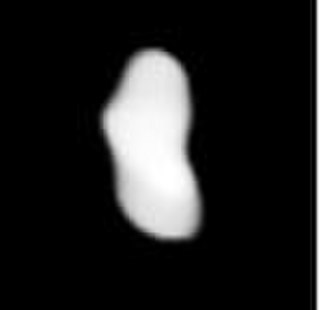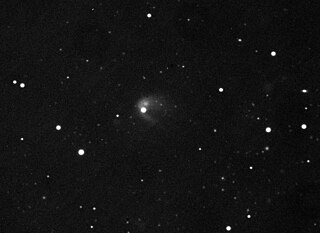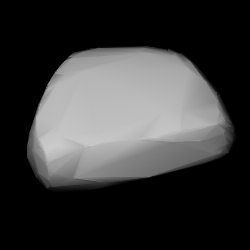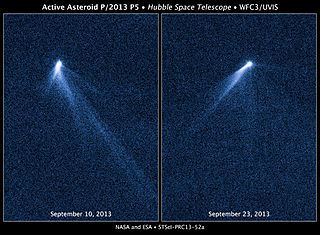
Ausonia is a stony Vestian asteroid from the inner region of the asteroid belt, approximately 100 kilometers in diameter. It was discovered by Italian astronomer Annibale de Gasparis on 10 February 1861, from the Astronomical Observatory of Capodimonte, in Naples, Italy. The initial choice of name for the asteroid was "Italia", after Italy, but this was modified to Ausonia, an ancient classical name for the Italian region.
2069 Hubble, provisional designation 1955 FT, is a carbonaceous asteroid from the outer region of the asteroid belt, approximately 40 kilometers in diameter. It was discovered on 29 March 1955, by the Indiana Asteroid Program at Goethe Link Observatory, United States, and named after American astronomer Edwin Hubble.
2159 Kukkamäki, provisional designation 1941 UX, is a stony asteroid from the inner region of the asteroid belt, approximately 11 kilometers in diameter. It was discovered on 16 October 1941, by Finnish astronomer Liisi Oterma at Turku Observatory in Southwest Finland. It was later named after Finnish geodesist Tauno Kukkamäki.
Croatia, provisional designation 1906 TM, is a dark asteroid and parent body of the Croatia family, located in the outer regions of the asteroid belt, approximately 88 kilometers in diameter. It was discovered in 1906, by astronomer August Kopff at Heidelberg Observatory, and later named for the independent country of Croatia, then part of Austria-Hungary.
647 Adelgunde, provisional designation 1907 AD, is a stony asteroid from the inner regions of the asteroid belt, approximately 13 kilometers in diameter. It was discovered on 11 September 1907, by German astronomer August Kopff at Heidelberg Observatory in southern Germany. The origin of the asteroid's name is unknown, it may be derived from the name of Princess Adelgunde of Bavaria.

Active asteroids are small Solar System bodies that have asteroid-like orbits but show comet-like visual characteristics. That is, they show a coma, tail, or other visual evidence of mass-loss, but their orbits remain within Jupiter's orbit. These bodies were originally designated main-belt comets (MBCs) in 2006 by astronomers David Jewitt and Henry Hsieh, but this name implies they are necessarily icy in composition like a comet and that they only exist within the main-belt, whereas the growing population of active asteroids shows that this is not always the case.

4492 Debussy is a dark and elongated background asteroid and binary system from the intermediate asteroid belt, approximately 15 kilometers in diameter. It was discovered on 17 September 1988, by Belgian astronomer Eric Elst at Haute-Provence Observatory in France. It was later named after French composer Claude Debussy.
1096 Reunerta, provisional designation 1928 OB, is an asteroid from the background population of the asteroid belt's central region, approximately 40 kilometers in diameter. It was discovered on 21 July 1928, by astronomer Harry Edwin Wood at the Union Observatory in Johannesburg, South Africa. The asteroid was named after South African engineer Theodore Reunert, supporter of the observatory and friend of the discoverer.
3673 Levy, provisional designation 1985 QS, is a binary Flora asteroid from the inner regions of the asteroid belt, approximately 6 kilometers in diameter. It was discovered on 22 August 1985, by American astronomer Edward Bowell at Lowell's Anderson Mesa Station near Flagstaff, Arizona, United States. The asteroid was named after Canadian astronomer David H. Levy.
12359 Cajigal, provisional designation 1993 SN3, is a carbonaceous Themistian asteroid from the outer region of the asteroid belt, approximately 12 kilometers in diameter.
3277 Aaronson, provisional designation 1984 AF1, is a carbonaceous asteroid from the outer region of the asteroid belt, approximately 20 kilometers in diameter. It was discovered by American astronomer Edward Bowell at Lowell's Anderson Mesa Station, near Flagstaff, Arizona, on 8 January 1984, and named in memory of astronomer Marc Aaronson.
4151 Alanhale, provisional designation 1985 HV1, is a carbonaceous Themistian asteroid from the outer region of the asteroid belt, approximately 19 kilometers in diameter. It was discovered by the American astronomer couple Carolyn and Eugene Shoemaker at the U.S. Palomar Observatory, California, on 24 April 1985. It was named for American astronomer Alan Hale.
1929 Kollaa, provisional designation 1939 BS, is a stony Vestian asteroid from the inner regions of the asteroid belt, approximately 7 kilometers in diameter. It was discovered by Finnish astronomer Yrjö Väisälä at Turku Observatory in Southwest Finland, on 20 January 1939. The asteroid was named after the Kollaa River in what is now Russia.
3133 Sendai, provisional designation A907 TC, is a stony Flora asteroid from the inner regions of the asteroid belt, approximately 8 kilometers in diameter. It was discovered on 4 October 1907, by German astronomer August Kopff at Heidelberg Observatory in southwest Germany. The asteroid was named for the Japanese city of Sendai.
2019 van Albada, provisional designation 1935 SX1, is a stony Florian asteroid and former spacecraft target from the inner regions of the asteroid belt, approximately 8 kilometers in diameter. It was discovered on 28 September 1935, by Dutch astronomer Hendrik van Gent at Leiden Southern Station, annex to the Johannesburg Observatory in South Africa. The asteroid was later named after Gale Bruno van Albada.

HR 8799 b is an extrasolar planet located approximately 129 light-years away in the constellation of Pegasus, orbiting the 6th magnitude Lambda Boötis star HR 8799. It has a mass between 4 and 7 Jupiter masses and a radius from 10 to 30% larger than Jupiter's. It orbits at 68 AU from HR 8799 with an unknown eccentricity and a period of 460 years, and is the outermost known planet in the HR 8799 system. Along with two other planets orbiting HR 8799, the planet was discovered on November 13, 2008 by Marois et al., using the Keck and Gemini observatories in Hawaii. These planets were discovered using the direct imaging technique.

354P/LINEAR, provisionally designated P/2010 A2 (LINEAR), is a small main-belt asteroid that was impacted by another asteroid sometime before 2010. It was discovered by the Lincoln Near-Earth Asteroid Research (LINEAR) at Socorro, New Mexico on 6 January 2010. The asteroid possesses a dusty, X-shaped, comet-like debris trail that has remained nearly a decade since impact. This was the first time a small-body collision had been observed; since then, minor planet 596 Scheila has also been seen to undergo a collision, in late 2010. The tail is created by millimeter-sized particles being pushed back by solar radiation pressure.

311P/PanSTARRS also known as P/2013 P5 (PanSTARRS) or (Jasurbek) is an active asteroid discovered by Bryce T. Bolin using the Pan-STARRS telescope on 27 August 2013. Observations made by the Hubble Space Telescope revealed that it had six comet-like tails. The tails are suspected to be streams of material ejected by the asteroid as a result of a rubble pile asteroid spinning fast enough to remove material from it. This is similar to 331P/Gibbs, which was found to be a quickly-spinning rubble pile as well.

(300163) 2006 VW139, provisional designations 2006 VW139 and P/2006 VW139, as well as periodic cometary number 288P, is a kilometer-sized asteroid from the outer regions of the asteroid belt and the first "binary main-belt comet" ever discovered.

324P/La Sagra is an active asteroid with an orbital period of 5.44 years. It has been found to be active in more than one perihelia, indicating that the source of activity is sublimation.












